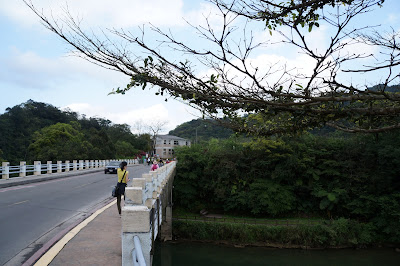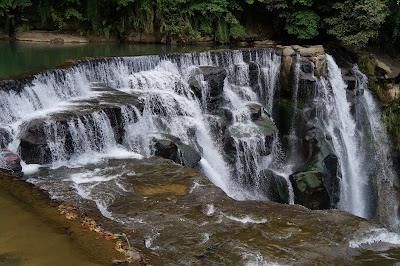Taiwan has three scenic branch lines, along with the Alishan scenic railway. These are railway lines deemed uneconomic for normal operation which now exist solely for tourist trains. Naturally, I was attracted!
The closest of these, and one of the more scenic, is the Pingxi line. It once served coal mines in the mountains around New Taipei City, but these are all long closed and it has now been converted for scenic operations.
To reach the Pingxi line we first had to catch a train to Ruifang on the Eastern line. The staff at Taipei's Main Station were very helpful, a roaming attendant assisting us with the ticket machine. We also purchased day passes to the Pingxi line from the prepaid ticket counter.
The orange train that pulled up on platform four looked old and a little decrepit on the outside. There was only one door per carriage and a huge crowd of passengers was trying to squeeze out of the narrow exit. At the same time passengers were attempting to board. It's every person for themselves in Taiwan, like on the mainland.
Fortunately, we had prebooked seats, though of course somebody was already sitting in ours. They moved without any trouble, but were left, like many others, standing in the aisles of the express.
We had each bought a small bottle of flavoured milk for our breakfast on the train: chocolate, apple and lemon flavours. Nice.
The first part of the ride, until after Zhongshan station, is underground, then you emerge into what look to be dormitory and industrial areas alongside some river and mountain scenery. The buildings are grimy, yet retain some design on their exteriors. Had we not been familiar with Japan the first impression would have been ugliness, but you learn to look beyond the concrete and tiled walls to see something more.
That's what Taiwan was to our eyes: A dirtier, rougher version of Japan with Chinese touches.
station was Ruifang.
There we joined the disembarking scrum and squeezed our way down the stairs, following the crowd. Most were probably destined for Juifen, another place I greatly wanted to visit, but it turned out we needed to return to our original platform and wait 45 minutes for a train on the Pingxi line.
When it arrived it was three carriages and everyone was spread out for at least five. The crush on the last carriage of the DMU, and presumably the others, rivaled anything in peak hour Shinjuku. There was literally no standing or seating space left (unless you were in India and we weren't). Worse still, Alex wanted to sleep and B had to put him on her shoulder while I held my heavy daypack in one painful hand. Somehow we managed to swap.
Though it may have been a scenic line I had almost no view of the exterior and certainly no room to take photos when I did. Eventually, at Shifen, many got out and there was some breathing room and a seat for B and Alex, but the train was still crowded. And this was supposed to be low season for tourism! Oh how I longed for the lonely rural lines of Japan.
We stayed until the train reached its terminus in Jingtong where we squeezed out as other travellers returning down the line attempted to squeeze in. There was a narrow "old street" running off from the original wooden Japanese style station. Unfortunately, I didn't have a chance to enter the old railway shop.
The toilet food of last night wanted to return to its source, but there were only open urinals for the men.
Hanging everywhere were lengths of bamboo on which love messages had been written.
We walked the short length of the old street and purchased lime and konnyaku jelly drink, what (we later discovered) might have been a pigs blood and rice concoction on a stick (discarded: not nice) and chicken, taro and carrot wrapped in a tofu sheet and deep fried. It's local to the town and tastes quite good. Alex demanded, and got, a fried pork sausage.
Then he joined many others and played on the disused railway tracks beneath the decaying concrete coal loaders. I would love to have spent more time exploring the town, but the trains only come roughly every 45 minutes, so we joined the crowd on the return trip.
We skipped the town of Pingxi, for which the line is named and famous for its paper lantern festival, and stayed until Shifen.
The platform at Shifen is far too narrow for the number of passengers, especially when one crowd is trying to get on as another is attempting to exit. It's elbows and bag blocking without any apology or excuse me.
The railway line runs straight through the main street of Shifen. It's another "old street" with stalls selling mostly fried food and trinkets. Once the train is gone the paper lantern vendors setup across the tracks. For a sum you can paint messages hoping for good luck (I saw requests for love, promotions, education and money) on the sides of these big paper balloons. A fire is then lit beneath and they soar off into the sky, destination unknown.
The shop and house facades in Shifen retain a grimy old art deco style clad in ceramic tile or concrete and overlook the river or the railway. A long suspension walking bridge shakily crosses the river, and we crossed and returned as Alex laughed away with the wobbles. Then, after one false start, we set off for the waterfall viewing area.
It was a long, long walk. After the town petered out there were farms and then moss, bamboo and fern clad rocks. We made it to the visitors information office just in time for me to use a squat toilet for the second time in my life. Lucky I had my own tissue paper stashed away, for there was none available inside.
Another suspension bridge leading to nowhere crosses the river. The waterfall viewing area was further down and we had to pay an entrance fee to gain access.
The falls are quite attractive and there are dining and play facilities on the site, which is designed with Chinese iconography.
I don't know why there's no station at the Shifen falls, because the railway line runs right beside the lookout area. On our return to Shifen we followed the tracks until the river, where we crossed over yet another suspension bridge and up past a restaurant. Then it was along a road - no footpath - trusting that this was the right route back.
We knew we were okay when we arrived at the level crossing, much to Alex's excitement. I had filmed a train going through on the way to the waterfall. Back in Shifen we watched a train passing through the centre, then quickly made our way to the platform.
Fortunately, the next train terminated at Shifen before returning, so we managed to snare a seat by pushing through the crowd.
At Ruifang we only had short wait before a local train bound for Taipei and beyond pulled up. No booked seating on this commuter style train, but B got a seat and I stood and snapped photos through the door windows, watching the red ball of the sun set behind the hills.
Back at Taipei's main station we decided to go to the famous Shilin night markets for a street food dinner. The MRT took us to Jiantan station and we joined the mass walking to the lights of the market.
The food stalls are crammed into a couple of narrow streets between clothing shops, with the actual night markets further up. The crowd was just as bad as on the trains, with almost no room to move. We bought a bun, but there was just no chance to look and think about the many interesting foods on offer, so we ate almost nothing.
With both Alex and B starving we eventually stopped in a regular restaurant opposite the food stalls. It sold pork stewed in an unappetising (for me) Chinese medicinal smelling broth, along with thin rice noodles or rice. Alex devoured the noodles, while B took to the pork ribs. I ate nothing, not feeling hungry. With all the walking and crowds my stomach was not feeling hungry.
Giving up on the market, we decided that we preferred the quieter street stalls around the Longshan temple, so headed back to the main station and our hotel. I was in chafed agony and could barely walk.
One the way to the hotel we stopped by a dumpling shop, where Alex gobbled up fried and steamed dumplings meant for me. He likes these more familiar foods.
It's a pity that the crowds spoiled what would otherwise have been very enjoyable experiences. Individually, the Taiwanese have been very friendly, it's just large masses of them that make life difficult. So far my top travel tip for Taiwan would be to come on a weekday!
Photos













































Comments